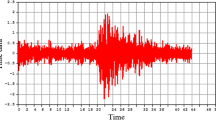Abstract
Based on dynamic elastic–plastic time history analysis method, dynamic responses of sandy slope in different groundwater levels are studied under near field earthquakes and far field earthquakes. The results show that the accelerations of the slope decrease with the increasing of groundwater levels, which demonstrates that the existence of groundwater damps vibration. The accelerations have different laws along the height of the slope under far field and near field earthquakes, however, the maximum values all appear at the top of the slope. The maximum horizontal displacement of the slope increases with the increasing of groundwater levels. The influence of far field earthquake on the deformation of slope toe is greater, while the influence of near field earthquake on the deformation of the slope top is greater. Thus, the top and the toe of the slope should be protected as the key position under earthquakes. The influence of high groundwater level on stability of the slope is more serious, and the safety factor calculated by pseudo-static method in slope seismic code will be lower for the slope in the high groundwater level.















Similar content being viewed by others
References
Ausilio E, Conte E, Dente G (2000) Seismic stability analysis of reinforced slopes. Soil Dyn Earthq Eng 19:159–172
Cai D, Huang S, Yan H, Chen F, Zhang Q, Yao J (2015) Quasi static analysis on influence of rising of groundwater level on side-slope stability. Railw Eng 1:56–62
Dawson EM, Koth WH, Drescher A (1999) Slope stability analysis by strength reduction. Geotechnique 49(6):835–8401
Deng R (2009) Analysis of subgrade stability considering ground water level fluctuations. J Railw Eng Soc 39(2):288–292
Dong J (2011) Permanent displacement assessment of slope protected by soil nailing retaining wall under earthquake. Eng Mech 28(10):101–103
Griffiths DV, Lane PA (1999) Slopes stability analysis by finite elements. Geotechnique 49(3):388–403
He P, Yao L, Liu L, Chen Q (2009) Reliability analysis of a slope considering the randomness of groundwater table. J Jilin Univ 39(2):288–292
Institute of Japan Highway (2001) Design specification of japan highway bridge (explanation). Maruzen Ltd., Tokyo
Jia GW, Zhan Tony LT, Chen YM, Fredlund DG (2009) Performance of a large-scale slope model subjected to rising and lowering water levels. Eng Geol 106(2):92–103
Jibson RW (2011) Methods for assessing the stability of slopes during earthquakes—a retrospective. Eng Geol 122:43–50
Jin Y, Dai F (2007) Analysis of loess slope stability due to groundwater rise. J Eng Geol 15(5):599–606
Kim JM, Sitar N (2012) Probabilistic evaluation of seismically induced permanent deformation of slopes. Soil Dyn Earthq Eng 44(1):67–77
Lane PA, Griffiths DV (2000) Assessment of stability of slopes under drawdown conditions. J Geotech Geoenviron Eng 126(5):443–450
Lin Y, Yang G (2012) Seismic residual deformation behavior of embankment slopes of different compaction degrees. J Cent South Univ 43(9):3631–3637
Lu L, Wang ZJ, Song ML, Arai K (2015) Stability analysis of slopes with ground water during earthquakes. Eng Geol 193:288–296
Ministry of Railways of the People’s Republic of China (2009) Code for seismic design of railway engineering (GB50111-2006). China Planning Press, Beijing
Singh PK, Wasnik AB, Kainthola A, Sazid M, Singh TN (2013) The stability of road cut cliff face along SH-121: a case study. Nat Hazards 68(2):497–507
Singh PK, Kainthola A, Singh TN (2015) Earthquake induced rockfall along cut slopes—a case study from Luhri, Himachal Pradesh. In: ISRM regional symposium EUROCK 2015, Salzburg, Austria. pp 1127–1132
Tao L, Yan Z, Jia X, Chai H (2014) Research on influence of reservoir water level changes on stability of roadbed slopes. Technol Highw Transp 1:1–6
Tong F, Tian B, Liu D (2008) A coupling analysis of slope runoff and infiltration under rainfall. Rock Soil Mech 29(4):1035–1040
Zhang L, He M, Zheng M, Yang F, Yang P (2009) Effects analysis of rainfall infiltration on the landslide seepage field and stability. J Railw Eng Soc 7:15–19
Zhu X, Shang Y (2008) Analysis of groundwaters effect on stability of debris slope. J Geol Hazards Environ Preserv 9(3):42–45
Acknowledgments
This work is financially supported by the Beijing talents Fund (2015000057592G270) and research grant from Institute of Crustal Dynamics, China Earthquake Administration (No. ZDJ2016-12).
Author information
Authors and Affiliations
Corresponding author
Rights and permissions
About this article
Cite this article
Huang, S., Lv, Y. & Peng, Y. Dynamic Response of Sandy Slope Under Coupling of Earthquake and Groundwater. Geotech Geol Eng 34, 889–899 (2016). https://doi.org/10.1007/s10706-016-0014-x
Received:
Accepted:
Published:
Issue Date:
DOI: https://doi.org/10.1007/s10706-016-0014-x




